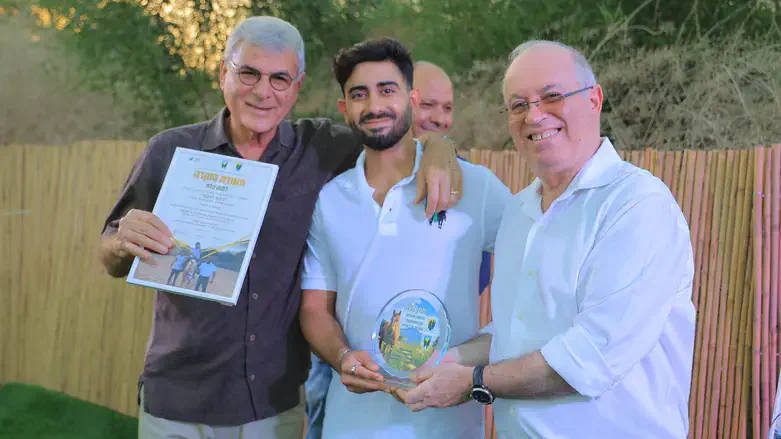
Last night, a touching graduation ceremony took place for the first cohort of the Hero to Hero program at Haida Ranch in Moshav Hemed. This innovative rehabilitation program brings together two unique populations—IDF soldiers wounded during Operation Iron Swords and young adults with special needs who serve in the IDF as part of the Special in Uniform program. During the ceremony, as emotions ran high, rocket sirens blared—a painful reminder of the security situation that many of the program’s participants live through daily.
Avivit Malka Ben Gaon, founder of the program, described the moments during the sirens as extraordinary: "The moment the sirens went off, it was a powerful and emotional scene. Wounded soldiers lay over their Special in Uniform comrades, hugging and comforting them—just like comrades in arms on the battlefield. It was a moment of deep connection, where the true strength of the program was revealed—wounded soldiers and individuals with special needs supporting each other, even in the most difficult moments.
You could see how some participants were scared while others tried to calm them down, with some even starting to sing to break the tension. Soon after the sirens ended, everyone stood up, the band began to play, and suddenly everyone was singing together at the top of their lungs. This collective singing brought a great sense of calm. Commanders, donors, civilians, organization staff, religious and secular people, individuals with special needs, and 'normative' individuals alike—everyone was on the ground, protecting themselves and others. It was an unbelievable, powerful, and moving sight, where everyone was equal in that moment, regardless of background or status."
The Hero to Hero program is an initiative of Yad Layeled Hameyuchad, which also operates the Special in Uniform program, in collaboration with Jewish National Fund USA. The program aims to create a group rehabilitation process that unites two seemingly different populations who share experiences of struggle, strength, and resilience. Wounded soldiers and special needs participants support one another, with each serving both as a mentor and a mentee, a caregiver and a patient.
Avivit Malka Ben Gaon, founder of Gallop, a center specializing in trauma recovery through equine-assisted therapy, is the visionary and director of the program, which only began this year as a response to Operation Iron Swords. They don't just grow stronger together, Avivit explained. They build each other up and learn to face their pain as a united force. Each participant brings something unique to the rehabilitation process, resulting in a powerful connection that transcends physical healing.
The story of Matan Pelech, one of the program’s participants, exemplifies its profound impact:
Matan Pelech, 21, from Hod Hasharon, served as a soldier in the Nahal Brigade and was injured during combat in Gaza. He was part of the first battalion to enter Gaza on foot and fought there for almost two months. During one operation, while guarding a building that held 35 prisoners, he noticed a terrorist running toward his comrades. Without hesitation, Matan left his position to protect his fellow soldiers and was shot in the pelvis during the firefight. After being evacuated by helicopter and spending months recovering in Sheba Medical Center, Matan began his long rehabilitation journey.
My comrade Tomer and I prevented the terrorist from surprising the platoon and causing more significant damage, Matan recalls. I was hospitalized at Sheba for two and a half months, and I'm still undergoing rehabilitation. I had to relearn how to walk and sit. The Hero to Hero program was a ray of light for me during some very dark times. I even managed to ride a horse—an incredible achievement for someone like me.
Lieutenant Colonel (Res.) Tiran Attia, Director of Special in Uniform and Jewish National Fund USA representative, also praised the program’s significance and impact:
Hero to Hero is far more than physical rehabilitation, said Attia with emotion. It serves as a bridge between two worlds—wounded soldiers and the heroes of Special in Uniform. This encounter, where everyone stands on equal footing, reveals the true strength of the program. They’re not just learning from one another; they’re discovering that each one of them has something unique to contribute that the other didn’t have before.


Attia added: When we started this program, we didn’t realize how profound its impact would be on the participants. When you see a wounded soldier holding his head high and successfully riding a horse, alongside a special needs participant who’s helping and encouraging him, you understand that this program touches the soul of each individual.
The ceremony concluded with a tremendous sense of pride in the progress made by each participant, and above all, in the unique bond forged between the wounded soldiers and the young adults with special needs. Although it’s only in its first year, the Hero to Hero program has already proven its importance as a transformative initiative that creates deep connections between true heroes—each undergoing a journey of renewal and recovery.
